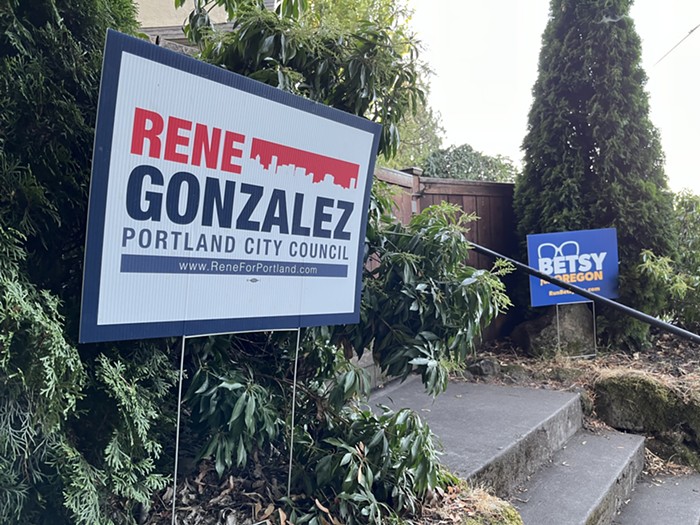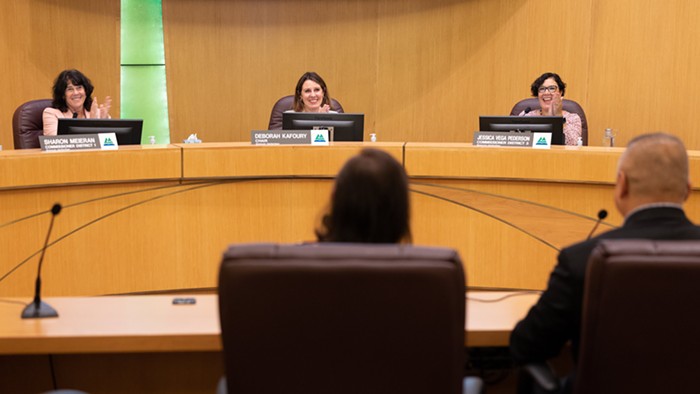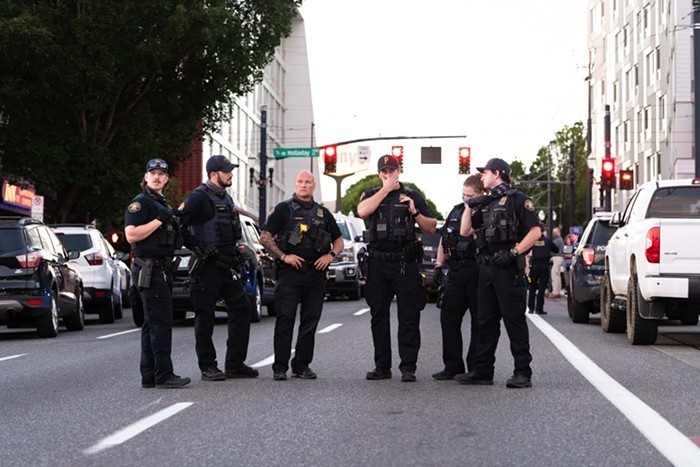
It's been six months since Portland police officer Zachary DeLong fatally shot Robert Delgado, a unhoused man residing in Lents Park. At the time, the public was told that officers arrived at the park after receiving a call describing a man playing with a handgun. Delgado, who appeared to be experiencing a mental health crisis at the time, allegedly pointed a fake handgun at officers before he was killed.
Now, two months after a grand jury cleared DeLong of any criminal charges for the shooting, believing he had acted in self defense, details of the incident and the following investigation have been made public. On Friday, the Multnomah County District Attorney's office and Portland Police Bureau made public hundreds of pages of public investigatory files into Delgado's death and a transcript of the September grand jury proceedings.
This new information, relayed mostly from members of law enforcement on the scene, helps answer some critical questions about what actually took place on the sunny morning of April 16, 2021 in Lents Park. Below, we use testimony collected from witnesses, detectives, officers, and medical experts to shine a light on some of these issues—and to illustrate what information grand jurors used to inform their decision not to charge DeLong.
What was Delgado doing before officers arrived on the scene?
Lents neighbor Chase Hagen was walking his dog down 92nd Ave. just south of SE Holgate with his fiance Kaela Ingle around 9 am on April 16 when they noticed Delgado. Hagen said he first thought the man in a bright red shirt and black pants standing in the back corner of Lents Park's baseball field was doing maintenance work. But they didn't finish their walk on the normal route. "Because... the person that was standing over there pulled from his... hip area what appeared to be a weapon, a firearm of some kind," Hagen told the grand jury. Hagen describes Delgado doing what he described as "a James Bond stance of both hands on the weapon... with both feet apart facing north." Delgado did not point the gun at the couple, but aimed it at various places in the park, as if practicing his aim.
That's when Hagen and Ingle decided to turn around and call PPB's non-emergency number to report Delgado. Hagen recalled characterizing Delgado's actions to be like those of a "gunslinger" to the operator.
Hagen and Ingle weren't the only people who saw Delgado that morning. David Hernandez had parked his car in the slim parking lot adjacent to the Lents Park baseball field around 6 am when he noticed a red tent in the middle of the field. Hernandez, who was sitting in the car with his partner, Anthony Adams, told jurors that an hour after parking, he watched Delgado exit the tent and walk toward his car. Hernandez was sitting in the driver's seat with the window rolled down.
"He's right at my window and we're talking and he seems totally coherent," Hernandez recalled. "He didn't smell like alcohol. He didn't seem high."
Hernandez noticed Delgado had the handle of a gun peeking out of his pants pocket. Delgado told him it was a BB gun. Hernandez and Adams shared cigarettes and a joint with Delgado as they chatted.
Hernandez said Delgado then returned to his tent and starting packing up his items, but not before "doing weird stuff to the air," according to Hernandez. He didn't elaborate on what that meant. Hernandez said he also saw Delgado pull out the gun and point it at the baseball field.
"He wasn't... threatening with it in any way," Hernandez said. Not long after, Hernandez watched two police cars pull into the parking lot. That's when he started filming with his cell phone.
When did Delgado's demeanor change?
Delgado's emotional state appeared to change as soon as officers attempted to talk with him. DeLong was the first to arrive at Lents Park, followed by fellow patrol officer Samantha Wuthrich. Both were responding to Hagen's allegations that a man was pointing a gun in the park, a fact that was further confirmed by Hernandez when they arrived. Hernandez said he yelled, "he has a gun," at the officers after they parked.
DeLong was carrying a rifle at his side when he exited his car. Wuthrich grabbed a 40 millimeter less-lethal launcher, a weapon that shoots foam-tipped projectiles.
DeLong told jurors that when he first saw Delgado, he thought, "he doesn't look enraged.... he's just standing with his hands empty." DeLong is part of PPB's Enhanced Crisis Intervention Team (ECIT), meaning he's received extensive training on engaging with people who may be having a mental health crisis and can be dispatched to a crisis to de-escalate a situation. Tapping into his ECIT training, DeLong said he calmly called across the filed to Delgado, "Hey, man, can you put your hands up and walk over to me?"
"And, at this point, he turned and looked at me and he went through the roof right off the bat," said DeLong. "And it, you know, caught me off guard big time. He was almost catatonic when I first called out to him. And he just went ballistic, started screaming, 'Get the fuck away from me,' and, 'Fuck you.'"
Wuthrich and DeLong were standing behind a tree at the time of this interaction, using the trunk as a shield. Wuthrich told the jury that Delgado was shouting,"Fuck you, kill me, fuck you guys, you're going to have to shoot me," while throwing his arms up in the air and pacing in the grass.
Hernandez witnessed the same transition from his car.
"[Delgado's] demeanor from when I first met him... completely flipped 100 percent," said Hernandez, explaining what happened after police approached Delgado. "He just got irate and wouldn't listen to any of the officers' commands."
Did DeLong try to de-escalate the situation?
Delgado's response to DeLong's initial question made DeLong suspect Delgado was more dangerous that he first believed. This instinct made DeLong cut short his attempts to deescalate the situation.
"Based on my training and experience, to see somebody go from zero to 100, from just nothing to completely enraged like this, what I'm thinking at this point is drugs, meth, some sort of stimulant," DeLong told the jurors. "Something has got him spun up."
DeLong said that, based on his experience, he knew that people who are high on meth are "unpredictable." That—plus the knowledge that Delgado allegedly had a gun—is why DeLong said he knew it was time to "change his demeanor" and be "authoritative."
"I said, 'Listen, man, if you reach for a gun, I'm going to fucking shoot you,'" DeLong recalled. "That sounds rough. I get that. But... it's a tactic. Part of the reason why I say it like that is to convey the seriousness of this to him."
That response only agitated Delgado more. DeLong recalled Delgado responding: "Oh, you're going to fucking shoot me? Well, fucking shoot me. Fucking shoot me."
DeLong said Delgado was "screaming, flexing, yelling incoherently."
"He, at one point, walked over to where [the] tent was," DeLong said. "And I remember he picked up this tent. I don't remember how, but he picked it up and he just hucked it to the wind."
DeLong continued to yell commands at Delgado, telling him to lie on the ground and raise his hands, and reminding him what would happen if Delgado reached for a gun. Delgado continued to yell and pace.
Other officers on the scene say DeLong's response is in line with PPB's crisis intervention training.
Officer Richard Bailey arrived at Lents Park as backup shortly after DeLong and Wuthrich showed up. Bailey who, like DeLong, is a trained ECIT officer, explained the thought process on engaging with people in mental health crisis to jurors.
"You know, if someone's unarmed, we'd approach them," Bailey said. "We could speak to them in a calm tone and we don't have any concerns with weapons. We... have time on our side. We don't have to act rapidly. It completely changes the game when someone's potentially armed with a weapon... That absolutely changes our ability to approach the situation."
Officer Ken Le, another ECIT officer on the scene, also explained how their training informed DeLong's actions.
"What we get trained to do is we try to engage with the subject in a sense of having a conversation to build rapport," Le said. "But because it seemed like to me...It seemed like the subject, all he was doing was just screaming. So there was really no way of building some sort of conversation during that time."
A representative from Oregon's Department of Public Safety Standards and Training (DPSST), the organization that provides basic training for all Oregon law enforcement, explained to jurors that DeLong's response followed DPPST training.
"Every situation's completely different," explained Scott Willadsen, a use-of-force trainer with DPSST, speaking about a hypothetical situation similar to DeLong's. "But in this situation where if I give the commands like 'do me a favor,' 'stay still,' 'don't move around very much,' 'don't reach for anything,' and they start to actually become more animated, that should trigger officers to become more concerned. And maybe now is the time to start drawing a gun. Not because I want to animate the situation any worse than it is, but words alone are not getting the response that I want."
Why did DeLong shoot Delgado?
Because Delgado allegedly pointed a gun at him.
Multiple officers and witnesses described Delgado rummaging around in his tent and possessions after DeLong initially barked orders at him, and then standing back up with a weapon in his hand.
"He went behind the tree and he bent down and we couldn't see what he was doing when he bent down," recalled Wuthrich. "And he stood back up behind the tree and he stepped around the tree and was just standing there with a gun pointed directly at me."
At the time, Wuthrich was standing right next to DeLong, who recalled the moment this way: "Mr. Delgado bent over, squatted down, reached down with one hand... And the very next frame that I can remember is him standing upright with his arm outstretched with a gun in his hand and I'm staring down the barrel of it. And it wasn't pointed at anybody else. It was pointed right at me."
"I thought, I'm going to get fucking shot," said DeLong. "It scared the shit out of me."
Wuthrich recalled that she and DeLong both shot at Delgado in unison. Wuthrich shot the less-lethal projectile while DeLong fired two bullets from his rifle. One of DeLong's bullets punctured Delgado's chest.
Why didn't officers shoot Delgado with the less-lethal weapon first?
It goes against police training protocol. According to Bradley Clark, a trainer with PPB, once an individual points a gun at officers, "There's no deescalation that will deal with that."
During the grand jury hearing, a Multnomah County prosecutor asked Clark to clarify that response.
"Once that gun is pointed at police or others, is it ever appropriate to just try less lethal first to see if the person lowers the gun?" asked Shawn Overstreet, a county deputy district attorney.
"No," Clark responded. That would not be the appropriate response, as far as our training goes."
Pressed to explain if there were any other alternatives to a firearm officers could have relied on to stop Delgado, Clark answered: "There's no other option."
"There's nothing else trained or taught that we have available to deal with that situation," he continued. "And if had something, we'd use it. If we had a tool that we could use at distance that would reasonably incapacitate someone at a less lethal level, we'd use it all the time. We don't have it. We've done a lot of research and development and tried a lot of these tools that people tout as the next big thing and... they're just highly ineffective."
Why did officers shoot if Delgado was holding a fake gun?
The officers didn't believe the gun was fake.
Both Wuthrich and DeLong told jurors that they believed the gun was a regular handgun, and said they had no reason to believe it was a replica. Only after Delgado died and officers retrieved the weapon did they notice it had an orange tip—indicating it was a replica.
Clark, the PPB trainer, said that, even if the officers saw the orange tip before shooting, it wouldn't have meant the gun wasn't real.
"Just because it has an orange tip does not necessarily mean that it is a fake gun," said Clark. "We have seen... people that have taken actual firearms and painted the tip orange so that people believe that they're fake. And for that very reason, just to make people hesitate in these moments, so you can't even count on that."
Clark continued: "The only way that you're ever going to know if a gun is real or not is by handling it, especially if it's a replica gun. They're designed and made specifically to look exactly like a real gun."
Why didn't officers immediately render medical aid to Delgado after he was shot?
Several witnesses to the shooting pointed out how long it took for officers to try and offer medical assistance to Delgado after he was shot. According to officers on the scene, this delay was out of concerns that Delgado was still armed and dangerous.
Bailey, one of the officers that arrived at Lents Park after DeLong, told jurors that, after he heard the gunshot and saw Delgado collapse, "it seemed like he was still moving around a little bit." Bailey wanted to offer medical aid, but hesitated.
"I'm not sure what was going on, but I believe that there was some potential that he was still alive," Bailey said. "I didn't know where the gun was. That was a strong concern. I didn't know if he was going to try to shoot us or if he was feigning injury or what was going on. I've seen past police videos and discussions that people feign injuries to ambush officers."
That's why Bailey said he decided to use his vehicle's PA system to order Delgado to put his hands in the air. Delgado didn't respond to any of the commands, but officers still couldn't tell where his weapon was.
"We don't know if he is playing possum and trying to to draw us into an ambush," recalled officer Cameron Smith, who had arrived at the scene to assist. Smith was ordered to shoot Delgado with another less-lethal projectile, to see if he'd respond. He didn't.
Bailey drove his car to where Delgado had fallen. Once he was close enough to see that the weapon was a few feet away from Delgado, officers began administering CPR. Those officers told the jury that Delgado didn't have a pulse when they reached him. Delgado was pronounced dead at the scene.
Would Delgado have survived the shooting if he received aid sooner?
It's unlikely, according to Sean Hurst, the chief medical examiner for the Oregon State Medical Examiner's Office. Hurst, who testified before the grand jury, preformed Delgado's autopsy.
During the grand jury proceedings, assistant attorney general Jayme Kimberly asked Hurst if he believed Delgado could have survived his gunshot wound if he had received quick medical care.
"I think that would be extremely unlikely," Hurst responded. "One of the things that people use to determine how severe an injury is and a person's likelihood for survival are the number of structures that are injured as well as the number of body cavities that are involved in a particular injury."
Hurst explained that the bullet struck Delgado in the left lung, diaphragm, spleen, and stomach.
"So here, we have injury to several organs in two body cavities, which would imply that it's a very serious injury."
Would the officers have done anything differently if they had another chance?
In grand jury testimony, Wuthrich is quick to dismiss the idea that she would have acted any differently. DeLong, however, considered it.
"Had I known that there was a gun and where it was," said DeLong, "I would have loved to have tried to have used the 40-millimeter launcher early, right on, just to prevent him from grabbing that [gun]."
"Hindsight's 20/20," he said.



















